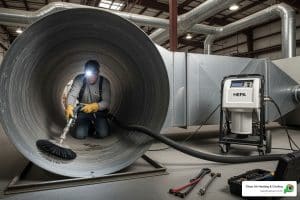If you are looking for a way to save money while staying cool in summer and warm in winter, mini-splits may be the answer to your problems! Homeowners all over Washington and the rest of the country are discovering the wonders of a mini-split air conditioning system, but many people have never even heard of this wonderful innovation. Join the Clean Air team as we take a closer look at why mini-splits are the best choice for your home!
What Is A Mini-Split?

Before we go any deeper into how mini-split systems work, let’s quickly go over what we even mean when we talk about mini-splits. A mini-split is an HVAC system that is split into multiple zones or separate areas within the home. Each zone has its own thermostat and air handler, meaning you can adjust temperatures in different parts of your home without affecting the other zones. Best of all, mini-splits are usually completely ductless, which means less energy output and more savings for you!
Mini-splits are becoming increasingly popular due to their flexibility, efficiency, and low initial cost compared to traditional central air systems. While they may not be ideal for large homes with complex HVAC needs, they are a great choice for small homes or apartments where space and budget are limited.
How Does A Mini-Split System Work?

A mini-split has two main components: an outdoor unit and several indoor units. The outdoor unit, or the condenser, is what pumps the cooled or heated air into your home. It is typically mounted on the wall or roof and looks similar to a traditional air conditioner. The indoor units, which are mounted in different areas of your home, are what actually circulate the air. Each indoor unit has its own thermostat, so you can control the temperature in each room independently.
The two main components are connected through suction lines, refrigerant lines, and power lines. Your home does not need any ducts for a mini-split air conditioning unit, so you never have to worry about a leaky duct or other complicated pieces. Mini-splits are available in a variety of sizes, so you can choose the one that best fits your needs. They are also available in both cooling-only and heating-and-cooling models, depending on what you need to keep your home comfortable.
Types Of Mini-Splits
There are a few different types of mini-split systems you could choose for your home, each with its own unique style and advantages. Mini-split systems can come in either ducted or ductless form, but the ductless feature of mini-splits is what makes this system so appealing. Ducted systems allow more flexibility in terms of where the air handlers can be installed, but they are much more costly and do not include the unique energy-saving features of a ductless mini-split system. Below are the most common types of ductless mini-splits.
Wall-Mounted Unit

Wall-mounted mini-splits are ideal for homes with no available space in the ceiling or on the floor. These units can be conveniently mounted to a wall and offer flexibility in terms of where they can be placed. The outdoor unit of a wall-mounted mini-split is typically mounted on the wall near an exterior window. The indoor unit is mounted on the wall in the room that you want to cool or heat. Portable or window air conditioning units are usually used for smaller rooms, but wall-mounted mini-splits are better for the following reasons:
- More energy-efficient
- More attractive
- Less obtrusive
- Multiple sizes/styles
Ceiling Cassette Unit

This type of mini-split is most often seen in commercial applications, as they are very powerful and can cool or heat a large space quickly. They are suspended from the ceiling and have a large grille that blows the air out into the room. Ceiling cassette units are not as common in homes, but they can be used in rooms where you want to maintain a uniform temperature throughout the space. The main advantage of a ceiling cassette unit is the fact that it can evenly distribute air throughout a large space. Some of the most common and noticeable features of this mini-split type are as follows:
- Quiet operation
- Space-saving design
- Even air distribution
- Powerful airflow
Floor-Mounted Unit

The major benefit of a floor-mounted mini-split unit is that you will feel the cool or warm air quicker than with other types of units. With the air handler on the floor, the output is much closer to the inhabitants of the room, meaning you will feel the effects of your mini-split unit almost immediately after turning it on. This option is also the easiest to clean and maintain because you have easy access to the air handler for any type of maintenance that may need to be done. Remember the reasons and benefits listed below when deciding whether a floor-mounted mini-split is right for your home:
- Immediate results
- Closer air handler
- Easy to maintain
- Quicker installation
Advantages Of A Mini-Split

The usage of mini-split units continues to grow in popularity as more and more homeowners seek out energy-efficient, cost-effective ways to cool their homes. Whether you’re looking for a new cooling solution or want to upgrade your existing air conditioner, a mini-split is an excellent choice that will keep your home comfortable all year round.
- No Ductwork: This means that you can save money on installation costs and avoid having to deal with ductwork maintenance. For homes that do not have pre-existing ductwork, mini-splits are a great option.
- Zone Control: Unlike traditional A/C units, mini-splits allow you to control the temperatures in individual rooms or zones of your home due to the multiple air handlers and lack of ducts.
- Energy-Efficient: Mini-split systems have proven to be up to 70% more energy-efficient than ducted systems. Ducted systems lose up to 30% of the air pushed by blowers, but mini-splits bypass this issue by transferring the air directly to the handlers through the lines.
- Cost-Effective: Considering the aforementioned air loss that takes place with a traditional blower, your energy bill increases as ducts become damaged or torn and lose more air. Less energy output means less money!
- Low Maintenance: Ducts need maintenance and repairs in order to keep working efficiently. Mini-split systems are perfect for people who just want to have their air conditioning unit installed and not have to worry about a thing.
- Less Noise: Large blowers of traditional systems are often extremely loud as they push the air all through the house. You will be stunned at the blissful silence you get with your new mini-split system!
Disadvantages Of A Mini-Split
While there are not many disadvantages to mini-splits, there are a couple of things to know when deciding if they are right for you. The main thing to remember is that mini-splits will cost a considerable amount of money in up-front costs. Depending on the type of mini-split and how many zones you need to condition, initial costs can be anywhere from $1,000 to $4,000. However, the savings you will see in your energy bills will quickly make up for the costs of installation!
The other main disadvantage is that you will have the air handlers visible in each room you wish to condition. Most people find the air handlers to be generally unobtrusive and minimally noticeable, but other people prefer to have the hidden vents of a traditional A/C system. If you have small rooms in your home and aesthetics are your top priority, this is a factor you may want to consider.
Mini-Splits vs. Central Air Conditioning
Mini-splits give you more control over where you want the air to travel in your home, as well as the temperature of the air in each room, as compared to central A/C. The various lines and components used by the mini-split system also tend to produce cleaner air, with the ability to dehumidify your home without cooling it like central air. Central air systems require less electrical work and do not cost as much money to install initially, but those savings are only temporary, and the energy-efficient mini-splits will quickly prove their value over the clunky blowers and ducts of central air systems.
Mini-Splits vs. Window Units
When it comes to choosing an air conditioner for your home, the most important question is what kind of space you need to cool. While window units are a popular choice, they may not be the best option if you have limited wall space, or if you want something that looks more attractive in your home. Mini-splits will not block out light and natural airflow the way a window unit does. Window units are also ugly and heavy, not to mention how dangerous they can be if they are not installed correctly. A wall-mounted mini-split unit near a window will always look more attractive and be more efficient than a window A/C unit.
Installing Mini-Splits In Your Home

A mini-split air conditioner is a great way to cool your home without the need for ductwork. They’re easy to install and maintain, and they offer many features that buyers are looking for, such as quiet operation and energy-saving modes. Also, remember that your mini-split system will require basic maintenance after installation. Air filters must be kept clean for maximum air quality and energy savings, and you should schedule regular maintenance to make sure everything is running smoothly. Have the following information ready before installation in order to make the process as simple as possible:
- Square-footage of your home
- Climate in your area
- Existing architecture
- Existing ductwork/electrical work
- Rooms/zones you want conditioned
- Your budget
Though mini-splits are relatively easy to install, this is only the case for professionals like Clean Air Heating & Cooling. No one should attempt a DIY mini-split installation, or else you could risk severely damaging your walls and existing electrical work. Call a local HVAC company for your mini-split installation, and you can just sit back and enjoy your air conditioning exactly the way you want it!





